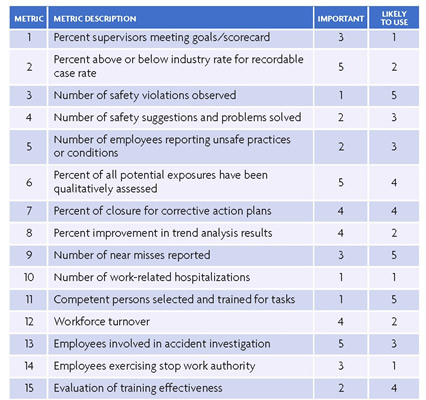Performance Metrics (Completed – 2004-2009)
Janie Gittleman, PhD, MRP
CPWR
Ph: 301-578-8500 ext.8533
: [email protected]
Year One:
The ultimate goal of this research is to create a practical product or tool that can track safety and health performance using leading, lagging and financial metrics in the construction industry, and also can be scaled to an organization’s size for its own use. The end product could be a checklist or a hand-held device that would set a new benchmark or best practice for field operations to prevent and reduce work-related injuries and illnesses. Although that end product has yet to be determined, interested parties, such as construction owners and contractors, insurance companies and regulatory agencies, have expressed strong interest in the outcome.
In Year One, the work of this team can be summed up in one word: outreach. First, the researchers recruited a group of experts representing a variety of perspectives related to construction safety and health performance to join a National Metrics Advisory Committee composed of general contractors, regulatory agencies, consultants, academics, insurers plus national organizations such as the Construction Safety Council, NIOSH and the Chicagoland Safety Council.

Researchers reviewed safety and health performance metrics literature, talked with practitioners and identified an expanded list of 223 metrics across six Occupational Safety and Health Administration performance categories: employee involvement, subcontractor safety and health, worksite hazard analysis, hazard prevention and control, health and safety training, and management leadership. CPWR’s National Metrics Advisory Committee narrowed the list to 95 metrics.
The team also sought content validation of the metrics by soliciting performance metrics ratings from a broad spectrum of construction stakeholders, contractors and safety and health representatives of contractors. In these rating sessions, contractors ranked metrics based on leading, lagging (such as workers’ compensation) and financial (such as cost of training and personal protective equipment) metrics they deemed important and likely to use on the job.
To date more than 230 contractors nationwide have rated these performance metrics for construction safety and health. They have also provided essential information on barriers and challenges to implementing metrics on construction sites and offered ideas for future products. Many contractors also requested the team’s rating worksheet as a tool to evaluate their own internal operations.
Research Team & Partners: Colorado State University; Stewart Burkhammer and Paul Esposito, C&R Consulting; Chicagoland Construction Safety Council; National Safety Council Construction Steering Committee; Tennessee Valley Authority Labor Management Committee; The Association of Union Constructors (TAUC); CPWR’s National Metrics Advisory Committee; National Association of Construction Executives; and more.
Abstract:
Problem to be addressed: Measuring safety and health performance in the workplace has been a challenge, particularly in the construction industry (NAICS 23) which consists of large numbers of mostly small employers where numerous parties are responsible for managing health and safety risks. These, and other, unique characteristics of the construction industry have created barriers to establishing an ongoing, systematic, and integrated collection of potentially useful information on the measurement and assessment of health and safety performance. The primary purpose of measuring health and safety performance is to provide information on the progress and current status of the strategies, processes and activities used to control risks to health and safety. Measuring safety and health performance helps to: 1) define goals in operational terms; 2) support continuous improvement; and 3) demonstrate the value of health and safety programs in business terms. Unfortunately, little apparent progress has been made in the last decade in developing a data system that supports the measurement of health and safety performance and the attainment of health and safety goals in the U.S. construction industry.
Impact of Research:
This information will help aid the construction industry in using leading indicators for monitoring trends in safety and health performance over time and for benchmarking improvements in preventing and reducing injuries and illnesses. Criteria will also be used to evaluate the feasibility and practicality of using a metrics rating tool. Insurance companies may also find this data valuable in evaluating construction firms’ workers’ compensation experience. Regulatory agencies such as the OSHA consultation program have expressed interest in the results for tracking, safety and health programs at the state and company level.
